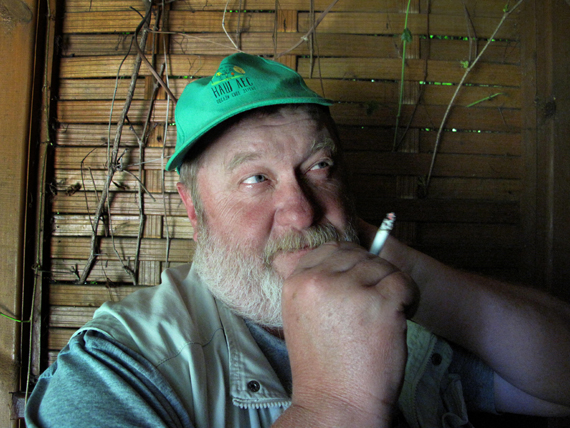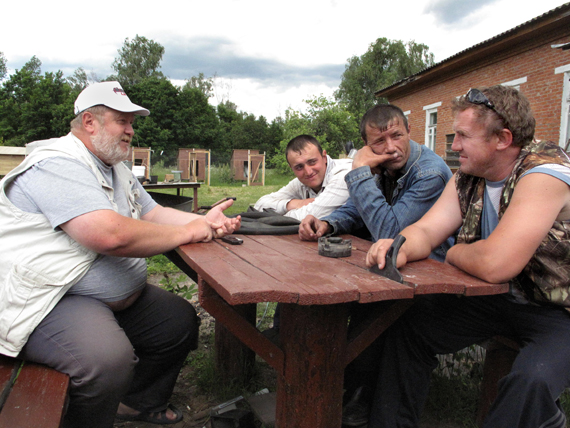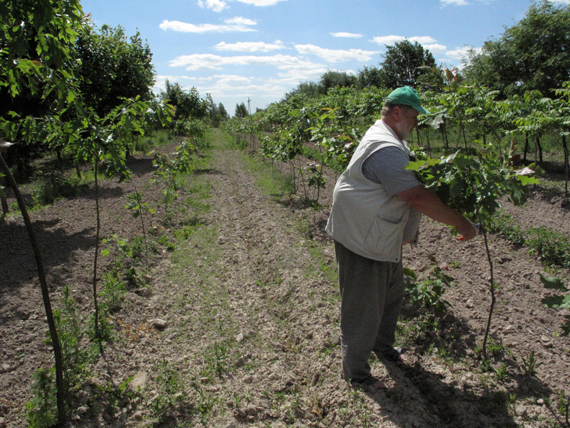On April 1st, the famous Russian farmer and crypto-enthusiast Mikhail Shlyapnikov has launched an ICO for his project “Kolionovo Ecosystem.” Cointelegraph spoke with Shlyapnikov to know more about his aims, motivations and what inspired him to apply the Blockchain at his farm.
The ICO is carried out on the Waves platform through the Emercoin service. One mln of Kolions are listed for initial sale during the next 30 days. The fundraising is scheduled to end on May 1st after that Kolions will be traded on the stock market.
As stated in the White Paper, the project is aimed at attracting additional investments for development of existing production line and a variety of services in Kolionovo village located in the Moscow Region.
It is also emphasized that the project should not be viewed as an investment opportunity promising high returns - it should only be considered as a crowdfunding tool for development of the Kolionovo ecosystem, a system of local production and consumption, which has been successfully operating for over a decade.
How one modest farmer tried to sabotage national monetary system
Shlyapnikov is leading a modest life, breeding ducks and hens and growing all sorts of plants.
He says:
“I don't have that much of a free time to dive deeper into studying digital currencies, their emergence, performance, following all these dramas happening in the space and predictions. Of course, I am trying to follow key trends and new projects. I have a laptop which is soon to turn seven years, an Internet connection through a USB modem which is far from stable, I am not quite able to speak foreign languages. But it doesn't stop me. I have my piece of land where I am working and I love what I do. Blockchain with all its benefits is not an object of adoration and worship for me, it is just a tool which has a potential to be applied in my farmstead. Just like a badass tractor pimped up with a bunch of cool stuff.”

- Mikhail Shlyapnikov. Photo: Nikita Girin / “Novaya Gazeta”
Long before the ICO Kolions have been in circulation used mainly by the community members of Kolionovo farm, its partners and customers. Mikhail Shlyapnikov, the man behind the project, created Kolions to order transactions between members of the Kolionovo farm.
In 2014 with the help of the local printing company he printed 20,000 Kolions, which basically looked like loan-certificates. His initiative immediately attracted the attention of the public prosecution office which claimed that Shlyapnikov is threatening the integrity of the national monetary system.
When officials from the Central Bank of Russia learned about the case they just shrugged their shoulders saying they see no harm in Shlyapnikov’s invention, as it’s totally up to the farmer how to handle a relationship with partners and customers and through which instruments.
One cannot simply put a cow on the Blockchain
We developed technologies, we taught computers to mimic real life processes and relationship. Now technology is teaching us to easily and continuously improve many organizational systems, simplify complex relationships and transform whole industries suggesting innovative approaches and models.
The young but quickly evolving Blockchain technology definitely has some social dimensions and it is interesting to watch the societal impact it is producing.
A few years ago we only thought that application of Blockchain technology is limited to the area of finances, it is becoming more and more obvious that its potential is unlimited.
The Russian farmer shows how it can transform agriculture. Obviously, one cannot put a cow on Blockchain, but it can be used to tame relationship with business partners and clients, while cryptocurrencies appear to be a perfect instrument for financing industries and projects all forgotten and abandoned by the state.
Shlyapnikov told Cointelegraph:
“First of all, I'm a farmer. I was interested in Bitcoin and Blockchain technology and decided to try it in my small business. Turns out it's quite easy, useful and lots of fun! In March 2017 we collaborated with Emercoin team and developed a package of ready-made solutions for farmers, providing a free and open access to it. This product has already attracted some interest. I would say that my enthusiasm is more about the application of cryptocurrencies in real life, rather than phenomena itself. Many people contact me asking questions concerning cryptocurrencies, but I just don't have enough competence in this matter. Perhaps this is one of the reasons why my project and ICO were met with irony at this fancy Blockchain party.”
Making digital and real worlds meet
The investments are linear by nature, therefore investing in Kolionovo Ecosystem is not about contributing to a single product but rather into expanding and growing the existing production. The growth of Kolions price is proportional to the growth of production volumes. The team behind the project also points out that Kolions holders will be able to purchase a number of products and goods with a discount of up to 100 percent.

- Photo:Nikita Girin / “Novaya Gazeta”
The key advantage of Kolions is that cryptocurrency is not linked to any traditional currency, it is linked to actual product and serves as an instrument for barter, which is as old as the universe.
With this project, Shlyapnikov suggests to step out of the crypto world and invest in something real. The project is not absolutely risk-free, however, all risks are coming from the real world, have nothing to do with attacks by hackers but rather with natural disasters and issues related to regulation of ICOs as an investment model in Russia.
In one of the interviews to the local media he once said:
“We hope that the government will not try to intrude into our small experiment in our small village. The fact that the experiment is unusual and creative does not necessarily mean that it is illegal. We are working to clearly define the terms of the project. Certainly, there are risks - an asteroid might hit the hen coop.”
Integration of Blockchain moved us from shadow economy
Last year the Kolionovo Ecosystem carried an ICO on Emercoin Blockchain. First in August partners issued digital equities and shares. They allowed attracting long money for improving the production line, investors in turns were able to purchase farm products with a discount.
Shlyapnikov says:
“During the eight months of this experiment we've got returns of almost 80 percent which were shared among participants. Those who live in Moscow Region receive it in the form of a "farm box", those are investors who live far away are getting their returns in BTC. In December last year using the same platform we have issued digital futures. They are not different from any transactions on blockchain but needed when the production needs more time. For instance making whiskey or growing trees. With time prices for these products are increasing and the price of digital token is growing as well.”
The entrepreneur says that the main conclusion from his experiments with cryptocurrency and Blockchain technology is that they blend well with real life, representing an alternative to bank services, more accessible and efficient.
He continues:
“This actually motivated us to create a digital currency of our own - KLN (Kolion). It is directly connected to the real product and is backed not only by investors' trust but also by real world assets. In November after the crop harvesting, we are planning to direct the profit to support our digital currency and cover investment maturity through purchasing or clearing of our cryptocurrency.”

- Photo: Nikita Girin / “Novaya Gazeta”
Through his tiny experiment, Shlyapnikov has demonstrated the enormous potential of cryptocurrencies and Blockchain solutions to be used in real life on daily basis. They allow fulfilling principles of P2P interaction to the fullest degree possible, eliminating the need for middlemen.
He says:
“In our case, we were able to push aside banks, retailers, logistics services and controlling authorities. It allowed us to significantly decrease nonmanufacturing costs. Partly we freed the state from the obligation to support us. Besides the integration of Blockchain moved us from shadow economy. To protect investments we had to register our assets and report everything publicly. Perhaps this might influence the state to change their attitude towards Blockchain technology and its application.”
Filling the gap between IT and agriculture
The Kolionovo Ecoproject is original and innovative in many respects. First of all, it has started without any prior promotion or media coverage.
Shlyapnikov explains to Cointelegraph:
“My Facebook page was the only platform which was actively used for promotion of the project. Later, of course, there were releases on the BTT forum. Interest in our project was growing steadily. Many people who were following the project from the very beginning were very supportive. Those who are not that familiar with what we are doing thought of it as of just another scam.”
Shlyapnikov says that some met his project with irony and were making sarcastic jokes like "peasant decided to crash fancy Blockchain party", or "how to brew homemade beer using cryptocurrencies", etc.
He says:
“Opinions vary significantly. One of the officials from the Central Bank of Russia contacted me saying that they are keeping an eye on my experiment. I'll repeat myself, but we were able to attract such a huge interest without any promotion.”

- Photo: Nikita Girin / “Novaya Gazeta”
The farmer is following the ideas of anarchism and says that it might not always be possible to create an anarchy in such a big country, but it is easy to start with a small community.
So far the project raised $20,000 in cryptocurrencies and ten times more in fiat. Shlyapnikov shares that the entrepreneur inside him is celebrating because this is a huge success. But as a researcher and pioneer of the idea to combine real life production and digital money, he is a little bit confused.
He concludes:
“Obviously there is a huge gap between the IT industry and traditional agriculture. Ideally, I would expect to see equal proportions of digital investments and those in fiat.”
